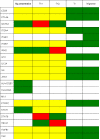A network analysis of the human T-cell activation gene network identifies JAGGED1 as a therapeutic target for autoimmune diseases
- PMID: 18030350
- PMCID: PMC2077806
- DOI: 10.1371/journal.pone.0001222
A network analysis of the human T-cell activation gene network identifies JAGGED1 as a therapeutic target for autoimmune diseases
Abstract
Understanding complex diseases will benefit the recognition of the properties of the gene networks that control biological functions. Here, we set out to model the gene network that controls T-cell activation in humans, which is critical for the development of autoimmune diseases such as Multiple Sclerosis (MS). The network was established on the basis of the quantitative expression from 104 individuals of 20 genes of the immune system, as well as on biological information from the Ingenuity database and Bayesian inference. Of the 31 links (gene interactions) identified in the network, 18 were identified in the Ingenuity database and 13 were new and we validated 7 of 8 interactions experimentally. In the MS patients network, we found an increase in the weight of gene interactions related to Th1 function and a decrease in those related to Treg and Th2 function. Indeed, we found that IFN-ss therapy induces changes in gene interactions related to T cell proliferation and adhesion, although these gene interactions were not restored to levels similar to controls. Finally, we identify JAG1 as a new therapeutic target whose differential behaviour in the MS network was not modified by immunomodulatory therapy. In vitro treatment with a Jagged1 agonist peptide modulated the T-cell activation network in PBMCs from patients with MS. Moreover, treatment of mice with experimental autoimmune encephalomyelitis with the Jagged1 agonist ameliorated the disease course, and modulated Th2, Th1 and Treg function. This study illustrates how network analysis can predict therapeutic targets for immune intervention and identified the immunomodulatory properties of Jagged1 making it a new therapeutic target for MS and other autoimmune diseases.
Conflict of interest statement
Figures





References
-
- Barabasi AL, Oltvai ZN. Network biology: understanding the cell's functional organization. Nat Rev Genet. 2004;5(2):101–113. - PubMed
-
- Lanzavecchia A, Sallusto F. Understanding the generation and function of memory T cell subsets. Curr Opin Immunol. 2005;17(3):326–332. - PubMed
-
- Crabtree GR. Contingent genetic regulatory events in T lymphocyte activation. Science. 1989;243(4889):355–361. - PubMed
-
- Hill N, Sarvetnick N. Cytokines: promoters and dampeners of autoimmunity. Curr Opin Immunol. 2002;14(6):791–797. - PubMed
-
- Steinman L, Zamvil S. Transcriptional analysis of targets in multiple sclerosis. Nat Rev Immunol. 2003;3(6):483–492. - PubMed
Publication types
MeSH terms
Substances
LinkOut - more resources
Full Text Sources
Other Literature Sources
Medical

